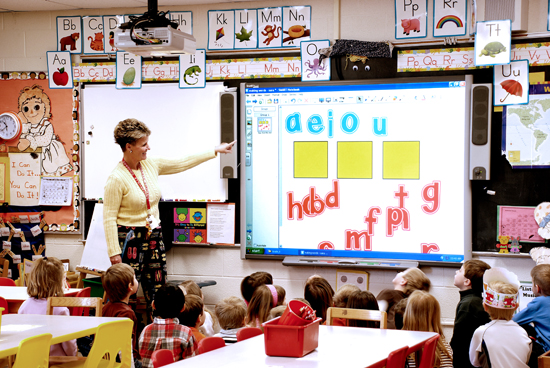 Reinventing education in a time of accelerating change is more important than ever before, especially if you’re at all interested in your kids and our future workforce being technologically savvy and possibly more so than any other workforce in the world.
Reinventing education in a time of accelerating change is more important than ever before, especially if you’re at all interested in your kids and our future workforce being technologically savvy and possibly more so than any other workforce in the world.
Normally I wouldn’t do a story on an interesting initiative with a marginally innovative technology perspective, but I’ve been writing for nearly six months for Scholastic, Inc. and their Administrator area online with a blog called “Accelerating Change.” As a consequence, I’ve been deeply involved in K-12 education technology study which has given me a unique perspective and I remain focused on uncovering true innovation or even incremental steps along the way toward true reinvention of education.
The PR gang over at Padilla Spears Beardsley, a group of folks whose quality public relations I’m continually impressed by, sent over some information on a Classroom of the Future initiative and their client, Tierney Bros, whose involvement in this worthwhile endeavor is worthy of note:
“People entering the workforce today are expected to have stronger technology experience and capabilities than ever before. Teachers today face the challenge of keeping pace with the latest technological advances – such as interactive presentation and conferencing technologies – with often limited resources.
For the fourth year in a row, Tierney Brothers is helping prepare the next generation of workers by offering a Tierney Brothers “Classroom of the Future” Technology Grant in both Minnesota and Wisconsin. This unique opportunity gives every school in Minnesota and Wisconsin the chance to receive $15,000 worth of technology, integration and training for their school. Students taught in these classrooms will learn using AV technology similar to systems Tierney Brothers, a leading provider of digital projectors, flat panel displays, systems integration, large format printers, graphic and engineering supplies, and audio and visual communication solutions has integrated into John Deere, Land O’Lakes, Wells Fargo and other businesses.”
Certainly a laudable initiative (especially with our State budget shortfalls) and an obviously smart thing for Tierney Bros to do since they’re in the business of selling this sort of gear in to K-12 education, but I’m doubtful these technologies are truly making classrooms future-ready and instead are putting a shiny new cover on a musty old book.
 In my research, study and conversations with K-12 leaders and teachers for my Scholastic blog, what I’ve seen over and over again is that the typical “classroom of the future” initiatives are like the photo you see above: same industrial classroom model of teacher at the board in front of the class (a model which would be instantly recognizable to a teacher from 1885!) but made slightly more efficient with projectors hooked to computers or interactive “smart” boards that are, in effect, giant touch screen interfaces for computers. The benefits of these devices, especially the smart board, are truly effective in engaging students with online resources.
In my research, study and conversations with K-12 leaders and teachers for my Scholastic blog, what I’ve seen over and over again is that the typical “classroom of the future” initiatives are like the photo you see above: same industrial classroom model of teacher at the board in front of the class (a model which would be instantly recognizable to a teacher from 1885!) but made slightly more efficient with projectors hooked to computers or interactive “smart” boards that are, in effect, giant touch screen interfaces for computers. The benefits of these devices, especially the smart board, are truly effective in engaging students with online resources.
But if I go to one more parent curriculum night at the start of a school year and the teachers gush about “all our new technology” and point to a projector or smart white board, I’m going to lose it.
I’ve also learned through various K-12 education studies that kids are usually bored with front-focused, teacher-centric classroom learning situations. Unfortunately teachers are locked in a systemic, assembly line model of moving kids through a curriculum, testing them to measure the learning, and progressing them through the school year to an outcome worthy of moving them on to the next grade level. Most teachers are so heads-down, and are themselves measured on, student performance to educational standards that there isn’t much time left to stand back and take a big picture view of the world our kids will inherit: a world that is moving faster and faster and one in which learning is quickly shifting online.
Anything that can help make the linear, serial educational process more efficient is noteworthy, which is why I laud efforts to help cash-strapped school systems introduce technology of any sort into that industrial age educational model. Though I really like what Tierney Bros is doing with this initative, in my opinion it’s not enough.
What’s needed? That’s outside the scope of this blog and my expertise, but when you see amazing stories like this one last night on 60 Minutes about The Harlem’s Children’s Zone, you realize that it’s not just technology that matters and that reinventing education is a highly complex issue. As I watched the story last night and thought about writing this post this morning, I realized that the leader of the program (Jeffrey Canada) had figured out how to optimize all the variables for his students to succeed within the current system and educational paradigm, but hadn’t revolutionized education with respect to the world his kids will live and work within when they graduate from college.
Amazed at the story, it still doesn’t point the way for preparing our kids for a world they’ll inherit that is accelerating so quickly that issues surrounding medical ethics, genetic modifications, the possibility of sentient machines and how to treat them, and doing ones work when most aspects of it have an internet-centric core and being savvy with dozens or hundreds of technologies will be “table stakes” to be in the game of life, are just a handful of areas our kids aren’t learning about today in that old model.